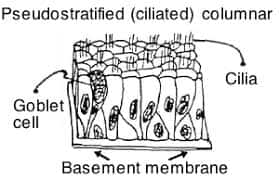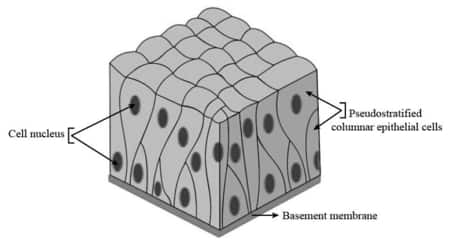Pseudostratified Epithelium
What Is Pseudostratified epithelium?
The pseudostratified epithelium is a class of epithelial tissue wherein the cells vary in height, thus giving an appearance of stratification or layering; however, it is only a single layer in which every cell extends to the basement membrane. Such tissue plays a crucial role in the body regarding protection, secretion, and movement of mucus. It is located prominently in the respiratory tract, including the trachea and bronchi, where it helps trap and transport particles out of the airways. Besides, pseudostratified epithelium can be found in parts of the male reproductive system; for example, the epididymis allows for the transit of sperm.
Don't Miss: Most scoring concepts for NEET | NEET papers with solutions
NEET 2025: Syllabus | PYQs | Crack NEET in 2 months - Study Plan
NEET Important PYQ & Solutions: Physics | Chemistry | Biology | NEET PYQ's (2015-24)
Structure Of Pseudostratified Epithelium
The structure of pseudostratified epithelium is described below-
Description Of Cell Arrangement
The pseudostratified epithelium has a single layer of cells, but its stratification is artificially created by the variable position of its nuclei. All the cells rest on the basement membrane despite this view.
Microscopic Appearance
The pseudostratified epithelium, under a microscope, appears in a sort of disorganised pattern with its nuclei resting at a different level from one another, creating the false impression of multiple cell layers.
Characteristics Regarding Positioning Of The Nuclei
The irregularly placed nuclei add to the impression that pseudostratified epithelium is stratified. This feature is thus useful in marking out pseudostratified epithelium from true stratified epithelium.
Differences From Other Epithelial Tissues
Whereas simple epithelium is formed by one layer of cells whose nuclei lie centrally and fairly consistently within the cell, and stratified epithelium consists of several distinguishable layers, the pseudostratified epithelium is a single layer of cells whose nuclei lie at different heights.
Types Of Pseudostratified Epithelium
The types of pseudostratified epithelium are described below-
Ciliated Pseudostratified Epithelium
Ciliated pseudostratified epithelium — The apical surface of the cells is covered with hair-like structures called cilia. This enables the epithelium to move the mucus and trapped particles out of the respiratory tract. Examples are the lining of the trachea and bronchi.
Diagram of ciliated pseudostratified epithelium

Non-ciliated Pseudostratified Epithelium
Non-ciliated pseudostratified epithelium lacks cilia and is concerned with absorption and secretion, rather than transportation. It can be found in parts of the male reproductive system, including in the epididymis.
Diagram of non-ciliated pseudostratified epithelium

Functions Of Pseudostratified Epithelium
The functions of pseudostratified epithelium are described below-
Protection
Pseudostratified epithelium protects against infection and physical damage, mainly within the respiratory tract.
Secretion
This epithelium is concerned with the secretion of mucus and other substances which entrap and clear foreign particles.
Absorption
In the male reproductive system, the non-ciliated pseudostratified epithelium enables the absorption of fluid in return for concentrating the sperm.
Transport Of Materials
The Ciliated pseudostratified epithelium transports mucus and with it, entrapped particles out of the respiratory system. It keeps air passageways clear.
Specific Functions Of The Respiratory Tract And Male Reproductive System
It filters and moves mucus in the respiratory tract. In the male reproductive system, this epithelium facilitates the movement and maturation of the sperm.
Locations In The Human Body
The locations of pseudostratified epithelium are described below-
Respiratory Tract
This pseudostratified epithelium lines a portion of the respiratory tract from the nasal cavity down through the trachea and bronchi, where it filters dust from inspired air.
Male Reproductive System
In the excurrent duct system, in the epididymis and vas deferens, it participates in the maturation and transport of sperm.
Other Locations
While it is primarily found in respiratory and male reproductive systems, the pseudostratified epithelium may localise into any other areas that bear such protective functions coupled with similar transport functions.
Recommended video on "Pseudostratified Epithelium"
Frequently Asked Questions (FAQs)
Pseudostratified epithelium refers to an epithelial tissue with an apparent multi-layered appearance; however, the tissue bears a single layer of cells that have varying height cell dispositions.
This epithelium is very common in the respiratory tract: nasal cavity, trachea, and bronchi; it may be found in parts of the male reproductive system, such as the epididymis and vas deferens.
The cilia on the pseudostratified epithelium beat to move mucus and trapped particles out of the respiratory tract, protecting it from pathogens and debris.
Unlike simple epithelium, with one layer of cells, and stratified epithelium, with multiple layers, the pseudostratified epithelium is a single layer of cells, but the nuclei of the cells are present at different levels and give a false impression of layering.
Such disorders are chronic bronchitis, primary ciliary dyskinesia, and different respiratory infections affecting the normal functioning of this type of epithelium.
Also Read
04 Oct'24 10:18 AM
01 Oct'24 01:26 PM
26 Sep'24 06:20 PM
19 Sep'24 10:56 AM
18 Sep'24 07:00 PM
18 Sep'24 03:42 PM
18 Sep'24 03:37 PM
18 Sep'24 03:02 PM
30 Aug'24 10:47 AM
30 Aug'24 10:29 AM